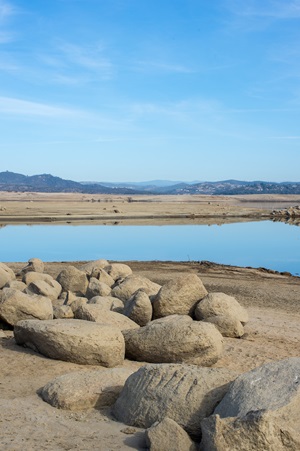Countywide Drought and Water Shortage Contingency Plans

Low water drought conditions at Folsom Lake.
In California, small water suppliers and rural communities were hit the hardest during the five-year drought that ended in 2016. In the worst cases, some rural and small communities saw their wells go dry. The State and counties provided bottled water and installed large water storage tanks for homes that ran dry. Small water systems can be more vulnerable to higher costs and water quality issues during prolonged dry periods.
Unlike their larger counterparts, small water systems are not required to maintain drought contingency plans. The lack of emergency/contingency plans left small and rural water systems and their stakeholders unaware of opportunities for assistance during the drought.
To improve water conservation and water shortage planning, Assembly Bill 1668 (Friedman), passed into law in 2018, directed DWR to do the following:
- Identify small suppliers and rural communities at risk of drought and water shortage vulnerability and
- Develop recommendations for improving drought contingency planning for those areas.
In coordination with multiple state agencies and vetted through an extensive stakeholder process, DWR developed recommendations that would allow small water suppliers and rural communities to meet their drought and water shortage planning needs. The report is available below. Also linked below is an online tool which enables small water suppliers and rural communities to explore their relative risk of drought and water shortage.
Report and Risk Explorer Tool
- Final Report
Small Water Systems and Rural Communities Drought and Water Shortage Contingency Planning and Risk Assessment:
- Part 1 – Recommendations for Drought and Water Shortage Contingency Plans (Report)
- Part 1 Appendix 1 - Literature Review
- Part 1 Appendix 2 - Proposed Water Shortage Contingency Plan Components for Small Water System
- Part 1 Appendix 3 - Proposed Umbrella Water Shortage Contingency Plan Components
- Part 1 Appendix 4 - Indian Health Service Template for a Drought Contingency Plan for a Tribal Public Water System
- Part 1 Appendix 5 - County Drought Advisory Group General Funding and Financing Issues
- Drought and Water Shortage Risk Explorer Tool for Small Water Suppliers and Rural Communities. See the tool for more information. If the hyperlink does not work, paste the following url into your browser: https://tinyurl.com/DWR-Drought-Risk-Tool (Recommended browsers: Google Chrome, Mozilla Firefox, Apple Safari, Microsoft Edge)
- Downloadable tables of drought and water shortage risk scores of all small water suppliers and rural communities examined, can be found at the CNRA Open Data website.
- DWR's Environmental Social Scientist Julia Ekstrom presented on the development of the Drought and Water Shortage Risk Explorer Tool for the California Natural Resources Agency 2020 Earth Day Science "TED Talks." Watch her presentation Water Shortage Risk in a Changing Climate: Science to Support Small Water Suppliers and Rural Communities. If hyperlink does not work, please paste the following url into your browser: https://www.youtube.com/watch?v=7Zfnjw-T_DY&feature=youtu.be
Contact Us
Email: WUE@water.ca.gov
